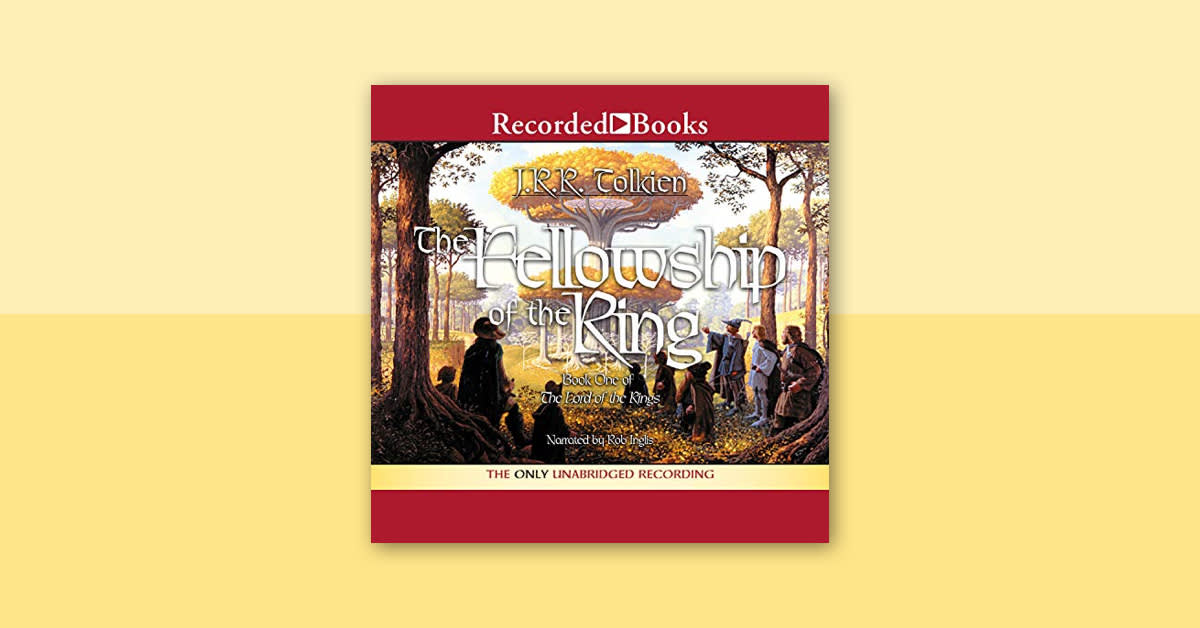Like James Joyce and Dr. Seuss, J.R.R. Tolkien, author of The Lord of the Rings epic, has an annual day devoted to reveling in his books. Established by the Tolkien Society in 2003. Tolkien Reading Day is held each year on March 25—the date marking the downfall of the terrible Dark Lord, Sauron (the Lord of the Rings). Before you dive into re-listening to your favorite Tolkien passages, why not take a few minutes to learn more about the writer, scholar, linguist, and visionary behind the fantasy phenomenon?
We'll start with a brief Tolkien biography and then provide answers to some of the most frequently asked questions from LOTR fans. But first off, let's make sure you know how to say the acclaimed author's name: It's pronounced Tol-keen, with an equal emphasis on both syllables.
Tolkien Trivia: According to Tolkien family legend, the surname is rooted in a German word, Toll-kühn, loosely translated as foolishly brave, or stupidly clever.
The real-life origins of J.R.R. Tolkien
John Ronald Reuel (J.R.R.) Tolkien entered the world on January 3, 1892. He was born in South Africa, where his parents had moved from England when his father, Arthur Reuel Tolkien, received a promotion from bank clerk to manager. When Ronald (as J.R.R. was known to family and friends) was four, his father died. Shortly after, he returned to England with his mother, Mabel Tolkien (née Suffield), and younger brother, Hilary. The family lived comfortably enough, in what could be described as genteel poverty. In 1900, Mabel converted to Catholicism, with a devotion to raising her boys in the faith. Four years later, she died from diabetes (a fatal disease in those pre-insulin days), entrusting the care, education, and spiritual welfare of her two orphaned sons to her parish priest, the half-Spanish, half-Welsh Father Francis Morgan.
Even as a tween in boarding school, Tolkien demonstrated his remarkable gifts as a linguist. Beyond mastering Latin and Greek, he had a working knowledge of Spanish, Welsh, French, German, Finnish, and Gothic (an extinct East Germanic language), and was already making up languages of his own for fun. After boarding school, he set out to study Classics at Exeter College, Oxford, but soon switched his major to the more congenial English Language and Literature. Shortly after graduating in 1915, he took a break from his studies to enlist as a second lieutenant in the First World War. After the Armistice, he briefly worked on the staff of The Oxford English Dictionary, and then returned to Oxford, earning his Masters degree in 1919. The following year, he launched his career in academia at the University of Leeds. In 1925, he secured a Professorship at Oxford, where he taught until his retirement in 1959.
All the while, throughout his studies, military service, stint as a lexicographer, and decades as a professor, Tolkien continued to amuse himself by inventing languages and writing fantasy tales. Some were dark and sorrowful, set in an elaborate world of his own creation, while others were lighter and often humorous. The longest and most important of Tolkien's more whimsical stories was The Hobbit, a coming-of-age fantasy about a diminutive, comfort-loving being, Bilbo Baggins, who joins a quest for a dragon's treasure. Published in 1937, The Hobbit was so popular that its publisher asked for a sequel. The result, 17 years later, was J.R.R. Tolkien's masterpiece, a modern version of the heroic epic, The Lord of the Rings.
Tolkien Trivia: While now routinely published in three parts—The Fellowship of the Ring, The Two Towers, and The Return of the King—The Lord of the Rings wasn't written as a trilogy. Running a whopping 1,728 pages, it was originally divided into three books to make it more marketable and to reduce the risk to its publisher should it fail to sell.
As we all now know, LOTR proved immensely popular and, after its 1965 release in paperback in the US, financially successful, going on to sell more than 50 million copies in some 30 languages. The novel (now widely regarded as a trilogy) inspired a series of three epic fantasy adventure films, released between 2001 and 2003. Director Peter Jackson, who also produced and collaborated on writing the scripts for the LOTR films, later adapted The Hobbit for screen as a trilogy: An Unexpected Journey (2012), The Desolation of Smaug (2013), and The Battle of Five Armies (2014).
So, that's the super-condensed version of J.R.R. Tolkien's life story. Here are more details, inspired by FAQs from the author's fans:
How old was Tolkien when he wrote The Hobbit? Was that his first book?
Tolkien began writing The Hobbit in 1930, when he was 38 years old, as a tale to entertain his four children. The novel took several years to complete and was published in 1937. Decades before he wrote The Hobbit, Tolkien invested countless hours in writing his "legendarium," partly to provide a setting for the Elvish languages he had invented. The birthplace of Middle-earth, this work eventually became The Silmarillion, which was edited and published posthumously by the author's son Christopher in 1977. Tolkien made his publishing debut in 1925, as a collaborator with E.V. Gordon on a translated collection of three medieval poems, Sir Gawain and the Green Knight.
Tolkien Trivia: Among his many talents, J.R.R. Tolkien was an accomplished amateur artist. The Hobbit was initially published with illustrations by the author himself.
What was the inspiration for Middle-earth? How many of Tolkien's books are set in Middle-earth?
In the course of his Old English studies as an undergrad at Oxford, Tolkien became fascinated by a poem, Crist of Cynewulf. He was particularly taken with a cryptic couplet that mentions "middangeard," an ancient expression for the everyday world between heaven above and hell below, which was translated into modern English as Middle Earth. In Tolkien's fantasy vision, Middle-earth became the perfect place for mortals to co-exist with imaginary beings, including Elves and Hobbits. In addition to Tolkien's best known works, The Hobbit and The Lord of the Rings saga, Middle-earth is the setting for The Silmarillion, The Children of Húrin, Tales from the Perilous Realm, The Fall of Gondolin, and Unfinished Tales of Númenor and Middle-Earth.
How many fictional languages did Tolkien create?
The answer to this question is a source of considerable debate among Tolkien scholars and enthusiasts. Indisputably, Tolkien fully developed two Elvish languages: Qenya, which was heavily influenced by Finnish, and Sindarin, the most common Elvish language, regularly spoken by Elrond and Legolas, among other characters. In addition, he invented vocabulary for 15 different Elvish dialects, along with languages spoken by the Ents, the Orcs, the Dwarves, and the Hobbits. Tolkien also created original alphabets to write his invented languages—Tengwar, which is used to write Qenya, is the one that appears most frequently in his work.
Was Tolkien a war veteran? Did he fight in World War I?
After completing his undergraduate degree at Oxford in June of 1915, Tolkien enlisted in the British Army as a second lieutenant with the Lancashire Fusilliers. He was sent to the Western front in France in 1916, just in time for the Battle of the Somme—a brutal, bloody struggle and one of the most lethal in British history. Tolkien served as a signaler, keeping communication lines open between army staff at the rear and front line officers in the field. The author's battlefield experience had a profound impact on his storytelling. During his World War I service, Tolkien drafted the first version of the War of Wrath, also called the Great Battle, uniting the Elves, Dwarves, and men against Morgoth, the main antagonist of The Silmarillion, and also began writing his masterwork, The Lord of the Rings.
Tolkien Trivia: While in the trenches of WWI, Tolkien was impressed by the courage of humble foot soldiers. Years later, the author stated that the characters of small Hobbits facing overwhelming odds stacked against them were inspired by the working-class men that kept fighting through extreme mental and physical hardships.
Is The Lord of the Rings an allegory?
In addition to drawing on his wartime experience, Tolkien's magnum opus reflects his views on the struggle between good and evil, the temptation of immortality, and the power of faith. Many scholars have described both Aragorn and Gandalf as Christ figures, and Tolkien himself has been quoted as describing LOTR as "a fundamentally religious and Catholic work." Yet, the author viewed LOTR as a fairytale, which he believed were important for adults as well as for children, rather than an allegory. "Fairy story has its own mode of reflecting ‘truth,’ different from allegory, or (sustained) satire, or ‘realism,’ and in some way more powerful," Tolkien wrote in a letter to a magazine editor in 1956. "But first of all it must succeed just as a tale, excite, please, and even on occasion move.”
Who were The Inklings? Was Tolkien friends with C.S. Lewis?
Early in his tenure at Oxford, Professor Tolkien became a founding member of a group of writers with ties to Oxford and similar interests, known as The Inklings. The name was purely facetious—a play on writing, not an indication, as sometimes speculated, that its members claimed to have an “inkling” of the Divine Nature. Other prominent members included Neville Coghill, famed for his modern English translation of The Canterbury Tales, and C.S. Lewis, an atheist turned theological author. As one of Lewis's closest friends, Tolkien was at least partly responsible for the future Mere Christianity author's return to Christianity—though Tolkien had hoped that Lewis would join the Catholic Church rather than become a committed Anglican. The Inklings regularly met for reading from their works-in-progress, conversation, and drinks.
Was Tolkien married? Did he have children?
At age 16, Tolkien met a kindred orphan, 19-year-old Edith Bratt. They quickly bonded over their mutual experience of loss and their mutual longing for a close, meaningful connection. When their friendship deepened and Tolkien's grades began to suffer, his guardian and spiritual caretaker intervened. Father Morgan forbade young Ronald from having any further contact with Edith—an older woman and a Protestant—until he was 21. Tolkien obeyed the priest's order with one notable exception: The night before his 21st birthday, he wrote Edith a letter, asking her to marry him. Edith had recently accepted another man's proposal, but, as she assured Tolkien, it was only because she believed he had lost interest in her. When the two met up soon after, she agreed to become Tolkien's wife and to convert to Catholicism. They tied the knot on March 22, 1916, at St. Mary Immaculate Roman Catholic Church in Warwick. Over the course of their marriage, which lasted until Edith's death in November 1971, they had four children: John Francis, Michael Hilary, Christopher John, and Priscilla Anne.
Tolkien Trivia: Edith was the inspiration for the character of Lúthien, an Elfin maiden, whose sweet love story with a mortal man, Beren, is mentioned in The Silmarillion and throughout The Lord of the Rings. After Tolkien's death, his son Christopher extracted threads of the tale from various works and wove them together in a novel, Beren and Lúthien. Tolkien and his wife are buried together in a single grave in the Catholic section of Wolvercote cemetery in the northern suburbs of Oxford. Their headstone reads:
*Edith Mary Tolkien, Lúthien, 1889–1971 *John Ronald Reuel Tolkien, Beren, 1892–1973
Why is Tolkien considered the Father of Fantasy?
J.R.R. Tolkien took high fantasy to a new and exciting level, and the success of LOTR made it possible for other authors to thrive by writing fantasy fiction. Examples of Tolkien's influence in the fantasy realm range from how George R.R. Martin built up his world of magic in his epic A Song of Ice and Fire series to Stephen King's use of a fictional language in The Dark Tower saga to numerous elements—a wizened old magician helping to guide the protagonist on their journey, an object infused with dark magic that affects the behavior of those near it, a Dark Lord who seeks power and immortality—in J.K. Rowling's Harry Potter series.
J.R.R. Tolkien died on September 2, 1973, but his legacy lives on. To end our journey, here are three of the many memorable quotes from the incomparable creator of Middle-earth and much beloved author:
“All we have to decide is what to do with the time that is given us.” -The Fellowship of the Ring
“Oft hope is born when all is forlorn.” -The Return of the King
"Go back? No good at all. Go sideways? Impossible. Go forward? Only thing to do. On we go." -The Hobbit
To see more quotes from Tolkien's writings, be sure to check out our list of the most inspiring quotes from The Lord of the Rings.






